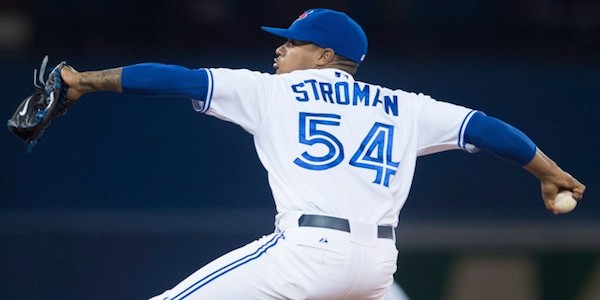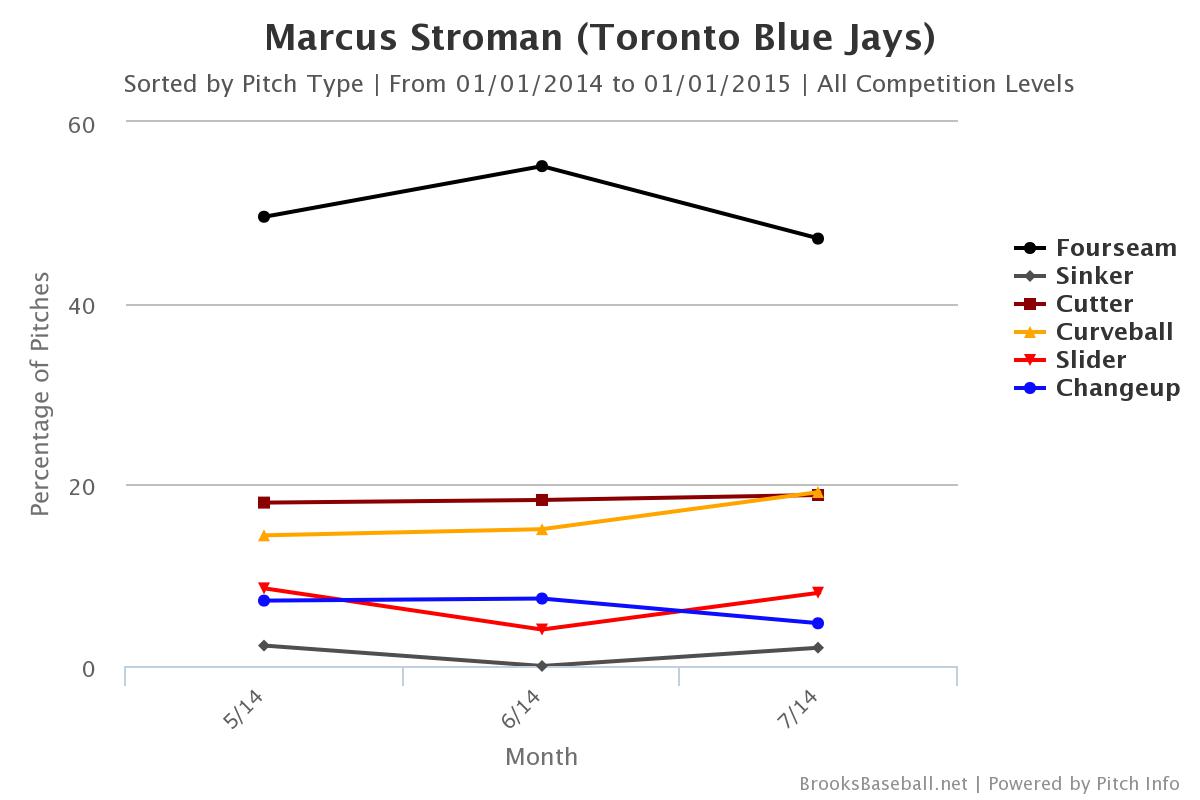2014 Fantasy Baseball: Marcus Stroman, Disturbingly Underdiscussed

It’s kind of hard to remember that Marcus Stroman was called up this season. It was a huge deal when it happened, but there hasn’t been much noise around him since, maybe it’s because the Blue Jays have fallen off. Still, he joined a struggling rotation that was basically just being asked to not blow games, because Toronto’s offense was so good. Well, he’s been everything they/we expected of him, possibly more.
Prospect coverage is so good in baseball today, that we’re immediately onto the next thing after one person is called up. Stroman’s up? Cool, what about Gregory Polanco, though? After Polanco was called up, we began focusing on Mookie Betts and Arismendy Alcantara. That isn’t a bad thing; it’s our nature. always looking at what’s on the horizon (Hi, Kris Bryant!) makes us miss what is happening in front of us, though. So, today, let’s appreciate Marcus Stroman.
[am4show have=’p3;p4;p7;p11;’ guest_error=’Front Office’ user_error=’Front Office’ ]
Among rookies, Stroman has had the sixth best season using fWAR. The catch? He’s only thrown 60 innings. The men above him have thrown (in ascending order from Tanaka down): 129, 59 (Betances, man.), 106, 107, and 82. Technically, he’s tied with Collin McHugh – Mr. 82 innings. Either way, he’s done a lot in a small amount of time.
As a starter (remember he was used in the bullpen immediately after arriving in Toronto), only Jesse Hahn and Matt Shoemaker have a lower FIP than Stroman’s 3.05; Masahiro Tanaka’s 3.07 isn’t far behind. But, as we know, things aren’t that simple. Hahn calls Petco Park home; Shoemaker calls the Angels’ spacious park home. Stroman? The Rogers Centre, baby! A hitter’s paradise. Once we adjust for the ballpark and other factors, Stroman comes out on top – or, since we’re using FIP-, on the bottom, posting a 76 FIP- (100 is league average; lower is better). Stroman’s end result has been great, but how has he gotten there? He’s had the holy grail: strikeouts, groundballs, and few walks.
As a starter, Stroman has struck out 22% of the batters he’s faced, walking only 6%; league average for both categories are 19% and 7%, respectively. He’s generated groundballs on 48% of the balls put in play; league average is 45%. So, at age 23, pitching in one of the friendliest offensive parks in the majors, Stroman is above average in three of the most important pitching categories. Not too bad. He’s also kept balls in the yard at a lower rate than normal. I only have good news. I bring you nothing but good tidings.
As we know, each pitcher arrives at their destination differently, so let’s view Stroman’s journey. First things first: pitch mix.
Stroman’s a fastball pitcher, first and foremost, using some variation of his heater (fourseam + sinker) a little over 50% of the time. If you were to include his cutter, he’d be closer to 70%. His curveball, his main secondary offering, is used nearly 20% of the time, which seems to be optimal use, as far as we know. He seemingly uses the pitch enough, but doesn’t throw it too much, perhaps a good thing considering the link between breaking balls and injuries. His slider is used roughly 8% of the time, but I wouldn’t mind seeing it used more, considering its effectiveness. He will also use his change-up to keep hitters honest, especially versus lefties, who see the pitch 10% of the time, compared to its basically nonexistent use versus right handed batters (1.5%).
Stroman hasn’t been in the league long enough to really point to one particular stretch of games and say: “This is how he should pitch. He was at his best when he was mixing his pitches this way.” What we do know, however, is that his slider is phenomenal, boasting a 23% swinging strike rate – a rate that is 8% greater than the league average. In February, Eno Sarris of Fangraphs, posted this piece, in which he identified benchmarks for each pitch. Only six pitchers had a swinging strike rate over 23% on sliders. Stroman’s offering, according to this metric is elite. Aside from his slider, though, Stroman’s offerings – excluding his change-up – hover around league average, using the swinging strike metric. That may not sound like much, but it’s simple really: he has one elite offering, three average ones, and one that’s below average. All in all, that’s a nice package. There is no real weak spot. His change-up could use work, but it isn’t a black hole; even so, its low usage rate sort of hides its deficiencies. Swinging strikes aren’t the whole story, though.
Swinging strikes are important, but they aren’t the only thing that matters; groundballs are the next most important thing, in my opinion. Using the benchmarks for groundball rates on pitches, Stroman’s very, very good. His fourseam, cutter, curveball, and slider generate more groundballs than average. His cutter is the money pitch, in this regard, generating groundballs on 62% of the balls put in play, compared to the average of 43%. His slider generates 13% more grounders than average. It isn’t super rare for a pitch to be above average in both metrics, but it’s rather impressive when one is above average by so much in both. Oh, and by the way, hitters chase 55% of the sliders he throws out of the zone. I realize I’ve spent a lot of time talking about a breaking ball that plays second fiddle to his curveball, but it’s impossible to not be enamored with this pitch; ask Eric Hosmer what he thinks about it.
Marcus Stroman has surpassed my expectations this season. I expected him to be good. I expected him to strike out his fair share of hitters. But I expected him to have some bumps along the way, and ultimately pitch to a high-3 or low-4 FIP. Outside of some immediate struggles, he hasn’t hit too many speed bumps. He’s gotten ahead of hitters and then put them away. He’s gotten harmless groundballs and kept balls in the yard, which is easier said than done for someone that’s well under six feet.
One of my favorite things about Stroman, though, is the fact that he isn’t scared of anyone. Scouting reports usually refer to shorter pitchers – Tim Hudson and Craig Kimbrel come to mind – as bulldogs, fierce competitors, guys who are in the majors because of their tenacity, not the fact that they possess more talent than 99% of the population (probably more directed at Hudson than Kimbrel on that one). I hate using an old cliche, because they’re usually rooted in race bias, among other things, but Stroman is a bulldog. He’s a bulldog in every sense of the word. Only eleven starters work faster than he does. He gets the ball and he throws it, in the zone, challenging hitters to do anything with it; he throws the hell out of it, too.
Damn if I don’t love watching Marcus Stroman pitch. I’m sincerely enthralled to watch how he’ll develop as a pitcher. No matter which route he chooses – more sliders; more change-ups, maybe? – he’s likely going to excel. His baseball acumen and stuff are awesome. Most importantly, he’s putting on for us short guys.
[/am4show]






